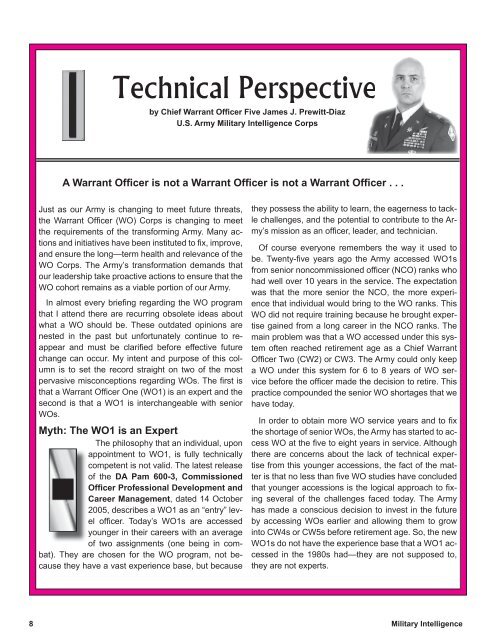Military Intelligence Professional Bulletin - Federation of American ...
Military Intelligence Professional Bulletin - Federation of American ...
Military Intelligence Professional Bulletin - Federation of American ...
Create successful ePaper yourself
Turn your PDF publications into a flip-book with our unique Google optimized e-Paper software.
8<br />
Technical Perspective<br />
by Chief Warrant Offi cer Five James J. Prewitt-Diaz<br />
U.S. Army <strong>Military</strong> <strong>Intelligence</strong> Corps<br />
A Warrant Offi cer is not a Warrant Offi cer is not a Warrant Offi cer . . .<br />
Just as our Army is changing to meet future threats,<br />
the Warrant Offi cer (WO) Corps is changing to meet<br />
the requirements <strong>of</strong> the transforming Army. Many actions<br />
and initiatives have been instituted to fi x, improve,<br />
and ensure the long—term health and relevance <strong>of</strong> the<br />
WO Corps. The Army’s transformation demands that<br />
our leadership take proactive actions to ensure that the<br />
WO cohort remains as a viable portion <strong>of</strong> our Army.<br />
In almost every briefi ng regarding the WO program<br />
that I attend there are recurring obsolete ideas about<br />
what a WO should be. These outdated opinions are<br />
nested in the past but unfortunately continue to reappear<br />
and must be clarifi ed before effective future<br />
change can occur. My intent and purpose <strong>of</strong> this column<br />
is to set the record straight on two <strong>of</strong> the most<br />
pervasive misconceptions regarding WOs. The fi rst is<br />
that a Warrant Offi cer One (WO1) is an expert and the<br />
second is that a WO1 is interchangeable with senior<br />
WOs.<br />
Myth: The WO1 is an Expert<br />
The philosophy that an individual, upon<br />
appointment to WO1, is fully technically<br />
competent is not valid. The latest release<br />
<strong>of</strong> the DA Pam 600-3, Commissioned<br />
Offi cer <strong>Pr<strong>of</strong>essional</strong> Development and<br />
Career Management, dated 14 October<br />
2005, describes a WO1 as an “entry” level<br />
<strong>of</strong>fi cer. Today’s WO1s are accessed<br />
younger in their careers with an average<br />
<strong>of</strong> two assignments (one being in combat).<br />
They are chosen for the WO program, not because<br />
they have a vast experience base, but because<br />
they possess the ability to learn, the eagerness to tackle<br />
challenges, and the potential to contribute to the Army’s<br />
mission as an <strong>of</strong>fi cer, leader, and technician.<br />
Of course everyone remembers the way it used to<br />
be. Twenty-fi ve years ago the Army accessed WO1s<br />
from senior noncommissioned <strong>of</strong>fi cer (NCO) ranks who<br />
had well over 10 years in the service. The expectation<br />
was that the more senior the NCO, the more experience<br />
that individual would bring to the WO ranks. This<br />
WO did not require training because he brought expertise<br />
gained from a long career in the NCO ranks. The<br />
main problem was that a WO accessed under this system<br />
<strong>of</strong>ten reached retirement age as a Chief Warrant<br />
Offi cer Two (CW2) or CW3. The Army could only keep<br />
a WO under this system for 6 to 8 years <strong>of</strong> WO service<br />
before the <strong>of</strong>fi cer made the decision to retire. This<br />
practice compounded the senior WO shortages that we<br />
have today.<br />
In order to obtain more WO service years and to fi x<br />
the shortage <strong>of</strong> senior WOs, the Army has started to access<br />
WO at the fi ve to eight years in service. Although<br />
there are concerns about the lack <strong>of</strong> technical expertise<br />
from this younger accessions, the fact <strong>of</strong> the matter<br />
is that no less than fi ve WO studies have concluded<br />
that younger accessions is the logical approach to fi xing<br />
several <strong>of</strong> the challenges faced today. The Army<br />
has made a conscious decision to invest in the future<br />
by accessing WOs earlier and allowing them to grow<br />
into CW4s or CW5s before retirement age. So, the new<br />
WO1s do not have the experience base that a WO1 accessed<br />
in the 1980s had—they are not supposed to,<br />
they are not experts.<br />
<strong>Military</strong> <strong>Intelligence</strong>
















